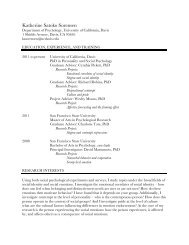The Psychology of Creativity:
The Psychology of Creativity:
The Psychology of Creativity:
Create successful ePaper yourself
Turn your PDF publications into a flip-book with our unique Google optimized e-Paper software.
History <strong>of</strong> <strong>Creativity</strong> Research 21<br />
elaboration <strong>of</strong> Darwin’s sexual-selection theory into a full-fledged explanation <strong>of</strong> human creativity and closely<br />
related behaviors.<br />
<strong>The</strong> second direction taken is to use Darwin’s evolutionary mechanism – variation and selection – as a<br />
model for how human creativity takes place. Put differently, new ideas emerge in the head by means <strong>of</strong> a process<br />
analogous to that by which new species originated on this planet. Although this application dates back to William<br />
James (1880), it did not receive full development until after Donald Campbell (1960) published his classic paper on<br />
his “blind-variation and selective-retention” model <strong>of</strong> creative thought. Since then, Campbell’s model has been<br />
progressively expanded and extended into a complex explanatory and predictive theory (e.g., Eysenck, 1993;<br />
Martindale, 1990; Simonton, 1999a). What makes this theory especially promising is its conceptual compatibility<br />
with the recent development within computer science <strong>of</strong> genetic algorithms and genetic programming (Martindale,<br />
1995). <strong>The</strong>se programs apply explicitly Darwinian principles to produce bona fide creative products (Koza, 1992,<br />
1994). In short, this variation-selection theory <strong>of</strong> creativity has the potential <strong>of</strong> providing a comprehensive<br />
theoretical account <strong>of</strong> human creative behavior (see also Sulloway, 1996).<br />
Past Achievements and Future Prospects<br />
<strong>The</strong> above narrative has been necessarily selective. In a single chapter is impossible to provide an<br />
exhaustive history <strong>of</strong> creativity research. Certainly another author might make contrary decisions about what should<br />
and should not be narrated (see, e.g., Albert & Runco, 1999). Still, the history I gave should suffice to indicate how<br />
far we have progressed in our understanding <strong>of</strong> creativity. A great deal has been learned about the creative process,<br />
the persons who engage in creative thought, and the products that result from that engagement. Furthermore, after a<br />
period in which creativity was considered a peripheral topic, it has now entered the mainstream <strong>of</strong> psychological<br />
research. This status is reflected in the diversity <strong>of</strong> subdisciplines that consider creativity a worthy subject for<br />
empirical and theoretical inquiry. A short list would have to include cognitive, developmental, personality, and<br />
social psychologies. Also to be considered a good indication <strong>of</strong> the health <strong>of</strong> creativity research is the fact that two<br />
recent movements within the field – evolutionary psychology and positive psychology – have both adopted<br />
creativity among their topics. All told, creativity research not only has a history, but also will continue to produce a<br />
history.<br />
But what will that future history be like? How will the narrative be written by a psychologist at the<br />
beginning <strong>of</strong> the 22nd century? It may be dangerous to indulge in prophecy, yet I do believe that the past does
















